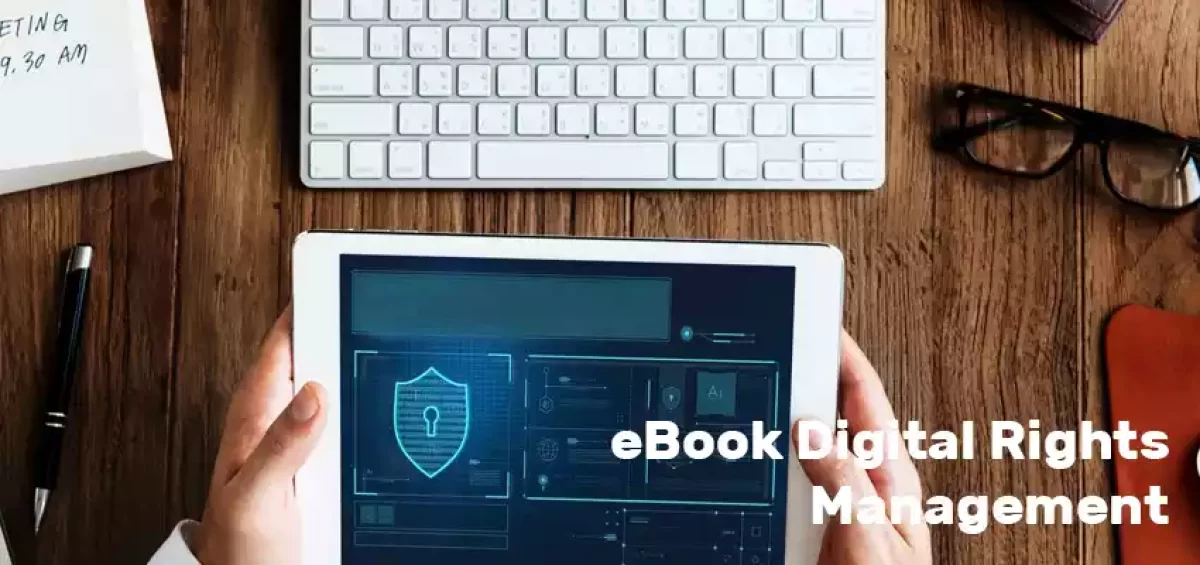Writing an eBook is no easy task. It takes a lot of hard work, dedication, expertise, and countless hours to create a perfect product for your readers. But once the eBook hits the market, there is one big challenge that is probably on your mind.
What happens if someone downloads your eBook and starts distributing it illegally? If this fear plagues you, you are definitely not alone! The publishing industry (which includes eBooks and print media) is the second most affected industry by piracy, representing 28% of global piracy traffic.
Fortunately, a way exists to protect eBooks from piracy while ensuring that your readers do not get hassled. This technology is known as eBook Digital Rights Management (DRM) solutions.
These solutions help publishers and authors secure their content and protect eBooks from unauthorized distribution. Keep reading to learn how eBook DRM systems work and the intricacies of their operation, helping you stay vigilant and limit access.
Table of Contents
I. What is eBook Digital Rights Management (DRM)?
II. Importance of Protecting Your eBooks
III. How DRM Protects eBook Content
IV. Implementing DRM in Digital Publishing
V. Conclusion
What is eBook Digital Rights Management (DRM)?
Digital Rights Management (DRM) is a sophisticated technology that helps retailers and publishers thwart unauthorized access and distribution of their eBooks.
At its core, DRM comprises a set of technologies and protocols designed to control access to digital content, such as eBooks. These protocols enforce usage policies set by content creators or publishers and act as deterrents for any illegal distribution of the material.
These policies may include restrictions on copying, printing, sharing, and accessing content across different devices or platforms.
Importance of Protecting Your eBooks
eBooks are easy to share and download, making them the perfect option when you want to reach readers across the world. However, with this newfound convenience comes the looming threat of piracy, which can undermine the efforts of content creators and publishers.
Since it is easier to reproduce, copy, and distribute, eBooks need to be protected using strong mechanisms such as:
1. Preservation of Intellectual Property
eBooks represent valuable intellectual property for authors, publishers, and content creators. Without adequate protection, eBooks are vulnerable to unauthorized copying, distribution, and exploitation, leading to potential revenue loss and erosion of trust among stakeholders.
2. Maintenance of Content Integrity
eBook piracy is a concern, but what about blatant plagiarism? DRM protected eBooks are safeguarded against tampering, unauthorized modifications, and the distribution of counterfeit copies.
By encrypting eBook files and embedding digital watermarks, publishers can deter illicit activities and preserve the integrity of their content. This not only protects the interests of rights holders but also upholds the credibility and quality of published works in the eBook readers‘ eyes.
3. Ensuring Legal Compliance
One of the major reasons for the increase in digital piracy is the inability of law enforcement agencies to trace the source of this distribution. Thus, despite knowing that downloading a pirated copy is unlawful, 27% of users have purchased a pirated eBook.
By implementing DRM measures, publishers demonstrate their commitment to upholding copyright laws and respecting the rights of content creators. This mitigates legal risks and fosters a culture of accountability and ethical conduct within the digital publishing industry.
How DRM Protects eBook Content
Now that we know the importance of protecting eBooks from online piracy let us understand what DRM systems do and the mechanisms that they use to safeguard eBook content effectively:
1. Encryption
1. Encryption
DRM implements encryption mechanisms for your eBook to prevent copying or unauthorized distribution of content.
eBook files are encrypted to render them unreadable without the corresponding decryption key, effectively preventing unauthorized access or tampering. By encrypting eBook content, publishers ensure that only authorized users with the requisite decryption key can unlock and access the protected material.
2. License Management
DRM protected eBooks employ license management mechanisms to regulate access to content and enforce usage policies defined by publishers.
Each authorized user is granted a unique license that specifies the terms and conditions governing their access to the eBook. This includes permissible actions (e.g., reading, printing) and usage restrictions (e.g., expiration date, device limitations).
By defining access and usability controls, you can facilitate the ethical distribution and validation of licenses and ensure that only legitimate users can access the protected content.
3. Digital Watermarking
Digital watermarks are pieces of code or semi-transparent text that can be added to your eBook files. Knowing that your eBooks are watermarked deters unauthorized copying, distribution, or content alterations.
These imperceptible identifiers serve as unique markers that can be traced back to individual copies, enabling publishers to track piracy or unauthorized sharing instances.
4. Authentication Mechanisms
DRM software also employs authentication mechanisms to verify the identity and credentials of users seeking access to protected eBook content. Users must authenticate themselves using valid credentials, such as usernames and passwords, before accessing the encrypted material.
This added level of security helps prevent unauthorized users from circumventing DRM protections and accessing protected content without proper authorization.
Implementing DRM in Digital Publishing
Want to implement DRM protection for your eBooks? Here are a few settings we recommend to help you secure your eBooks from piracy without becoming a hassle to your readers.
- Control Distribution: Prevent sharing, downloading, and copying of your eBook, ensuring that only you can distribute your eBook.
- Set Link Expiry & Download Limits: While you give control to devices and users for accessing your eBook, set the expiry date and limit the controls on each device. This helps ensure that even if unauthorized users manage to get hold of the link, they won’t be able to use it for too long.
- Define Access Controls: Set open limits, IP address limits, and access control by country. This allows you to control unauthorized access and usage, which can happen from certain IP addresses or specific locations.
- Add Unique User-Identifiable Watermarks: Use DRM to apply user-identifying watermarks to ensure that you know where the piracy occurred in case of violation. This also makes users with access more accountable and less likely to distribute your eBook.
Conclusion
By embracing these advanced DRM systems and technologies, publishers can fortify their eBook content against piracy, unauthorized distribution, and intellectual property theft while empowering users with secure, seamless, and personalized digital reading experiences.
While completely eradicating piracy is still a long haul, using DRM and similar protocols ensures this problem can be contained. It also ensures that the damage due to illegal distribution is limited and prompt action is taken against unauthorized users, making eBook reading and publishing a lot safer.
By partnering with digital publications like KITABOO, that have 128-bit encryption, you can ensure your eBook reaches a wider audience while enabling all safety measures. Our secure cloud-based distribution ensures that your content is DRM-protected and encrypted.
Plus, users can even safely download the book to be read offline.
To know more about this platform, contact us today!
Discover How An Ebook Conversion, Publishing & Distribution Platform Can Help You
Kitaboo is a cloud-based content platform to create-publish & securely distribute interactive mobile-ready ebooks.
You May Also Like
-
Step-by-Step Guide to Licensing Teaching Materials
Blog,Digital Publishing,eBook solution / February 22, 2024








